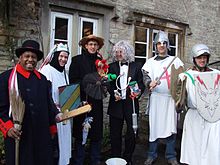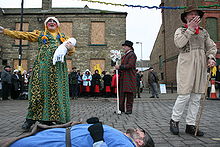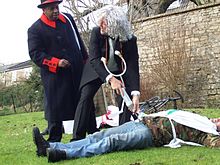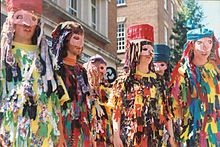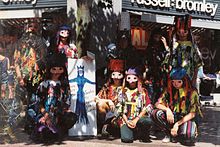- Mummers Play
-
"Mummer" redirects here. For other uses, see Mummer (disambiguation).Midwinter Mummers at the Whittlesea Straw Bear 2009

Mummers Plays (also known as mumming) are seasonal folk plays performed by troupes of actors known as mummers or guisers (or by local names such as rhymers, pace-eggers, soulers, tipteerers, galoshins, guysers, and so on), originally from England (see wrenboys), but later in other parts of the world. They are sometimes performed in the street but more usually as house-to-house visits and in public houses. Although the term "mummers" has been used since medieval times, no play scripts or performance details survive from that era, and the term may have been used loosely to describe performers of several different kinds. Mumming may have precedents in German and French carnival customs, with rare but close parallels also in late medieval England (see below).
The earliest evidence of mummers' plays as they are known today (usually involving a magical cure by a quack doctor) is from the mid to late 18th century. Mumming plays should not be confused with the earlier mystery plays.
Contents
Mummers' and guisers' plays
Mummers' and guisers' plays were formerly performed throughout most of Irish-speaking Ireland, Europe and Great Britain, as well as in other English-speaking parts of the world including Newfoundland, Kentucky and Saint Kitts and Nevis. In England, there are a few surviving traditional teams, but there have been many revivals of mumming, often associated nowadays with morris and sword dance groups.
Mummers and "guisers" (performers in disguise) can be traced back at least to the Middle Ages, though when the term "mummer" appears in medieval manuscripts it is rarely clear what sort of performance was involved. A key element was visiting people in disguise at Christmas. At one time, in the royal courts, special allegorical plays were written for the mummers each year — for instance at the court of Edward III, as shown in a 14th century manuscript, now in the Bodleian Library, Oxford. However, apart from being in rhyme, these plays were nothing like the current traditional plays, whose documented history only goes back as far as the mid-18th century.
Although usually broadly comic performances, the plays seem to be based on underlying themes of duality and resurrection and generally involve a battle between two or more characters, perhaps representing good against evil. Usually they feature a doctor who has a magic potion which is able to resuscitate a slain character. Early scholars of folk drama, influenced by James Frazer's The Golden Bough, tended to view these plays as debased versions of a pre-Christian fertility ritual, but this view is discounted by modern researchers.
In mummers’ plays, the central incident is the killing and restoring to life of one of the characters. The characters may be introduced in a series of short speeches (usually in rhyming couplets) in which each personage has his own introductory announcement, or they may introduce themselves in the course of the play's action. The principal characters, presented in a wide variety of manner and style, are a Hero, his chief opponent, the Fool, and a quack Doctor; the defining feature of mumming plays is the Doctor, and the main purpose of the fight is to provide him with a patient to cure. The hero sometimes kills and sometimes is killed by his opponent; in either case, the Doctor comes to restore the dead man to life.
The name of the hero in the English tradition is most commonly Saint George, King George, or Prince George. His principal opponents are the Turkish Knight (in southern England), or a valiant soldier named Slasher (elsewhere). Other characters include: Old Father Christmas (who introduces some plays), Beelzebub, Little Devil Doubt (who demands money from the audience), Robin Hood (an alternative hero in the Cotswolds), Galoshin (a hero in Scotland), etc. Despite the frequent presence of Saint George, the Dragon rarely appears in these plays, though it is often mentioned; a dragon seems to have appeared in the Revesby Ploughboys' Play in 1779, along with a "wild worm" (possibly mechanical), but it had no words to say. In the few instances where the dragon appears and speaks, its words can be traced back to a Cornish script published by William Sandys in 1833.
It is thought the tradition of the mummers came to Ireland through the arrival of the Normans although some scholars have argued that the ancient Irish had similar ceremonial activities to mumming that can be traced back as far as two millennia B.C.. Irish custom and tradition have permeated mumming ceremony in Ireland and there mumming often centres around famous characters from Irish history - Colmcille, Brian Boru, Art MacMorrough, Owen Roe O'Neill, Sarsfield and Wolfe Tone.
Occasionally, the performers will wear face-obscuring hats or other kinds of headgear, which create the impression of being masked. Some mummers' faces are blackened or painted red by way of disguise. Many mummers and guisers, however, have no facial disguise at all.
Mumming, at any rate in the South of England, had its heyday at the end of the 19th century and the earliest years of the 20th century. Most traditional mummers groups (known as "sides") stopped with the onset of the first World War. To most groups, mumming was a way of raising extra money for Christmas and the play was taken round the big houses. Most Southern English versions end with the entrance of "Little Johnny Jack his wife and family on his back". Johnny, traditionally played by the youngest mummer in the group, first asks for food and then more urgently for money. Johnny Jack's wife and family were either dolls in a model house or sometimes a picture.
Those involved with mumming groups were often unwilling to admit to it as they did not like to confess to begging. However it seems that it could be quite lucrative, it is said that three nights of mumming often raised as much as a whole month's wages for the agricultural labourers who mostly made up the groups.
Some groups continued after the first World War and even beyond the second, but most did not. The groups were normally based in a village and each village had a slightly different version of the play. In the second half of the twentieth century many groups were revived, mostly by folk music and dance enthusiasts. The revived plays are frequently taken around inns and public houses around Christmas time and the begging done for some charity rather than for the mummers themselves.
Early examples
Although there are earlier hints (such as a fragmentary speech by St George from Exeter, Devon, which may date from 1737, although published in 1770), the earliest complete text appears to be an undated chapbook of Alexander and the King of Egypt, published by John White (d. 1769) in Newcastle upon Tyne between 1746 and 1769.
The fullest early version of a mummers' play text is probably the 1779 "Morrice Dancers'" play from Revesby, Lincolnshire. The full text ("A petygree of the Plouboys or modes dancers songs") is available online.[1][2] Although performed at Christmas, this text is a forerunner of the local East Midlands variants usually performed on or around Plough Monday (see below) and often known as Plough Plays.
A text from Islip, Oxfordshire, dates back to 1780.[3]
A play text which had, until recently, been attributed to Mylor in Cornwall (much quoted in early studies of folk plays, such as The Mummers Play by R. J. E. Tiddy – published posthumously in 1923 – and The English Folk-Play (1933) by E. K. Chambers) has now been shown, by genealogical and other research, to have originated in Truro, Cornwall, around 1780.[4][5]
A play from an unknown locality in Cheshire, close to the border with Wales, dates from before 1788.[6]
Chapbook versions of The Christmas Rhime or The Mummer's Own Book were published in Belfast, c.1803-1818.[7] A mummers' play from Ballybrennan, County Wexford, Ireland, dating from around 1817-18, was published in 1863.[8]
Thomas Hardy's novel The Return of the Native (1878) has a fictional depiction of a mummers' play on Edgon Heath. It was based on experience from his childhood.
Local seasonal variants
 Antrobus Soul Cakers, in the mid 1970s, gathered round Dick, their Wild Horse
Antrobus Soul Cakers, in the mid 1970s, gathered round Dick, their Wild Horse
Although the main season for mumming throughout Britain was around Christmas, some parts of England had plays performed around All Souls' Day (known as Souling or soul-caking) or Easter (Pace-egging or Peace-egging). In north-eastern England the plays are traditionally associated with Sword dances or Rapper dances.
In the village of Ynysmeudwy in the Swansea Valley, the play was performed by four young boys who dressed as Crumpin John, Indian Dart, Robin Hood and a Doctor. The play was taken from house to house on Guy Fawkes evening; the performers being rewarded with money.
In the performances on the doorsteps there was always a sword-fight between Robin Hood and Indian Dart which ended with a death. The Doctor was called and the dead man was brought back to life and all ended happily.
This custom probably ended in the 1950s or 1960s
In some parts of Britain and Ireland, the plays are traditionally performed on or near Plough Monday and are therefore known as Plough plays. The performers were known by various names, according to area, such as Plough-jags, Plough-jacks, Plough-bullocks, Plough-stots or Plough witches. The Plough plays of the East Midlands of England (principally Lincolnshire and Nottinghamshire) usually have a different plot from the Christmastime "St. George" type of play and feature several different stock characters (including a Recruiting Sergeant, Tom Fool, Dame Jane and the "Lady bright and gay"). Tradition has it that plough boys would take their plays from house to house and perform in exchange for money or gifts, in a similar way to the American custom of Trick-or-treat; some teams pulled a plough and threatened to plough up people's front gardens or path if they did not pay up. Examples of the play have been found in Denmark since the late 1940s.
The Derby Tup
There are other traditional English folk plays which do not involve a quack doctor. Around Sheffield and in nearby parts of northern Derbyshire and Nottinghamshire a dramatised version of the well-known Derby Ram folksong, known as the Derby Tup ("tup" is another word for ram), has been performed, since at least 1895, by teams of boys. The brief play is usually introduced by two characters, an old man and an old woman ("Me and our owd lass"). The Tup was usually represented by a boy, bent over forwards, covered with a sack, and carrying a broomstick with a rough, wooden sheep's head attached. The Tup was killed by a Butcher, and sometimes another boy held a basin to catch the "blood". There is a Sheffield version where the Tup is killed and then brought back to life by the Doctor. This is the main play performed by the Northstow Mummers based in Cambridge.
The Old Horse
An 'Owd 'Oss play (Old Horse), another dramatised folksong, was also known from roughly the same area, in the late 19th[9] and early 20th centuries,[10] around Christmas. The custom persisted until at least 1970, when it was performed in private houses and pubs in Dore on New Year's Day.[11] A group of men accompanied a hobby horse (either a wooden head, with jaws operated by strings, or a real horse's skull, painted black and red, mounted on a wooden pole so that its snapping jaws could be operated by a man stooping under a cloth to represent the horse's body) and sang a version of The Old Horse or Poor Old Horse, which describes a decrepit horse that is close to death.
See also: Mari LwydThe Papa Stour Sword Dance
In 1831 Sir Walter Scott published a rhyme which had been used as a prelude to the sword dance in Papa Stour, Shetland in around 1788.[12] It features seven characters, Saint George, Saint James, Saint Dennis, Saint David, Saint Patrick, Saint Anthony and Saint Andrew, the Seven Champions of Christendom. All the characters are introduced in turn by the Master, St. George. There is no real interplay between the characters and no combat or cure, so it is more of a "calling-on song" than a play. Some of the characters dance solos as they are introduced, then all dance a longsword dance together, which climaxes with their swords being meshed together to form a "shield". They each dance with the shield upon their head, then it is laid on the floor and they withdraw their swords to finish the dance. St. George makes a short speech to end the performance.
See also: Rapper sword and Long Sword dance.
Etymology and early precedents
The word mummer is sometimes explained to derive from Middle English mum ("silent") or Greek mommo ("mask"), but is more likely to be associated with Early New High German mummer ("disguised person", attested in Johann Fischart) and vermummen ("to wrap up, to disguise, to mask ones faces"),[13] which itself is derived from or came to be associated with mummen (first attested already in Middle High German by a prohibition in Mühlhausen, Thuringia, 1351)[14] and mum(en)schanz, (Hans Sachs, Nuremberg, 16th cent.), these latter words originally referring to a game or throw (schanz) of dice.[15]
According to German and Austrian sources dating from the 16th century, during carnival persons wearing masks used to make house-to-house visits offering a mum(en)schanz, a game of dice. This custom was practiced not only by commoners, but also by the nobility: on Shrove Tuesday of 1557, Albert V, Duke of Bavaria went to visit the archbishop of Salzburg and played a game of dice with him.[15] A similar incident, involving an Englishman, is attested for the French court by the German count and chronicler Froben Christoph von Zimmern: during carnival 1540, while the French king Francis I was residing at Angers, an Englishman (ain Engellender) wearing a mask and accompanied by other masked persons paid a visit to the king and offered him a momschanz (a game of dice), bringing with him a sum of money which was so high that the king was ashamed not to have a similar sum at hand and had to wait two hours until the money could be lent from local merchants.[16]
While the game mum(en)schanz was played not only by masked persons, and not only during carnival, the German word mummenschanz nevertheless took on the meaning "costume, masquerade" and, by the 18th century, had lost its association with gambling and dice.
The custom attested for early modern Germany and France seems to have parallels also in late medieval England. According to History and the Morris Dance (2005) by John Cutting (page 81), there was a curious event in 1377, where 130 men on horseback went "mumming" to the Prince of Wales (later Richard II). They threw some dice, which appear to have been loaded dice, and so lost several gold rings. The rings were effectively presents for the prince. In 1418 a law was passed forbidding "mumming, plays, interludes or any other disguisings with any feigned beards, painted visors, deformed or coloured visages in any wise, upon pain of imprisonment". In the first case the event was on February 2, nine days before Ash Wednesday, and may well have been a carnival practice. In the second case, the law was applied to "the Feast of Christmas" (Cutting page 83), not related to the ordinary period of carnival preceding the Christian fasting of Lent, yet maybe related to Christmas fasting, which went ordinarily from November 11 to January 6.
It should be pointed out that there is no clear evidence linking these late medieval and early modern customs with English mummers' plays in the late 18th century, nor evidence for proving that the English words mummer and mumming are more likely to be derived from continental roots than vice versa.
Other kinds of Mummers
Feast Entertainers
Mumming was used as a means of entertaining at feasts and functions, particular mention is made of one feast where 150 torch bearers lead the same number of mummers in, who would do acrobatics in a variety of costumes, including animal costumes.
Social Mumming
At certain feast days (eg saint's days), a lot of the populace would put on masks, and in practices that vary with geography, celebrate the day. One practice in example was for a group to visit a local manor, and 'sing out' the lord. If the lord couldn't match verse for verse the singing group (alternating verses), then that lord would have to provide amenities.
The formation of roving mumming groups became a popular practice so common it became associated with criminal or lewd behaviour, as the use of masks allowed anonymity; and in the time of Henry the 8th, became banned for a period.
Aristocratic Mumming
On documents such as receipts and bills from the late medieval, come details of mumming parties organised by English Monarchs, with Henry VIII being famous for taking his court mumming, as a kind of incognito.
Later, Henry would ban social mumming, and bring the 'masque' form of entertainment to England.
Newfoundland Mummers
"Mummering" is a very old Newfoundland custom that dates back to the time of the earliest settlers who came from England and Ireland. It shares common antecedents with the Mummers Play tradition, but in its current form is primarily a house-visiting tradition. Sometime during the Twelve Days of Christmas, usually on the night of the "Old Twelfth", [people would disguise themselves with old articles of clothing and visit the homes of their friends and neighbours. They would at times cover their faces with a hood, scarf, mask or pillowcase to keep their identity hidden. In keeping with the theme of an inversion of rules, and of disguise, crossdressing was a common strategy, and men would sometimes dress as women and women as men. Travelling from house to house, some mummers would carry their own musical instruments to play, sing and dance in the houses they visited. The host and hostess of these 'mummers parties' would serve a small lunch which could consist of Christmas cake with a glass of syrup or blueberry or dogberry wine. Some mummers would drink a Christmas "grog" before they leave each house, a drink of an alcoholic beverage such as rum or whiskey. One important part of the custom was a guessing game to determine the identity of the visitors. As each mummers was identified, they would uncover their faces, but if their true identity is not guessed they did not have to unmask.
Philadelphia Mummers
Main article: Mummers ParadePhiladelphia, Pennsylvania, USA, has its own tradition of mummers marching on New Year's Day. About 15,000 mummers perform in the parade each year. They are organized into four distinct types of troupes: Comics, Fancies, String Bands, and Fancy Comic. All dress in elaborate costumes. There is a Mummers Museum dedicated to the history of Philadelphia Mummers.
Music
There are several traditional songs associated with mumming plays; the "calling-on" songs of sword dance teams are related:
- The Singing of the Travels by the Symondsbury Mummers, appears on SayDisc CD-SDL425 English Customs and Traditions (1997) along with an extract from the Antrobus, Cheshire, Soulcakers' Play
- It also appears on the World Library of Folk and Primitive Music. Vol 1. England, Rounder 1741, CD (1998/reis), cut#16b
- The Singing of the Travels was also recorded by the Silly Sisters (Maddy Prior and June Tabor). Silly Sisters, Takoma TAK 7077, LP (1977), cut# 6 (Singing the Travels)
- A Calling-on Song by Steeleye Span from their first album Hark! The Village Wait is based on a sword-dance or pace-egg play calling-on song, in which the characters are introduced one by one
- "The Mummers' Dance," a song from the album The Book of Secrets by Loreena McKennitt, refers to traditional mummers' play as performed in Ireland.
- England in Ribbons, a song by Hugh Lupton and Chris Wood is based around the characters of a traditional English mummers' play. It gave its name to a two hour programme of traditional and traditionally-rooted English music, broadcast by BBC Radio 3 as the culmination of a whole day of English music, on St George's Day 2006[17]
- The Mummer's Song, performed by the Canadian folk group Great Big Sea, but originally written by the Newfoundland folk band Simani, is an arrangement of the traditional song The Mummer's Carol, which details the mummering tradition in Newfoundland and Labrador
Also XTC released an album entitled 'Mummer' in 1983.
See also
- Adidam Mummery Sacred Theatre
- Balliol rhyme
- Clown
- Commedia dell'arte
- Jester
- Marshfield Mummers
- Mystery play
- Pantomime
- Revels
- St George's Day in England
- Wrenboys
References
- ^ The "Plouboys or modes dancers" at Revesby 1779
- ^ Morrice Dancers at Revesby — 1779
- ^ The Islip Mummers' Play of 1780
- ^ The Truro cordwainers' play: a "new" eighteenth-century Christmas play — Research article at BNET.com
- ^ Truro (Formerly Mylor): "A Play for Christmas", 1780s (Full text and notes)
- ^ Cheshire Play — Before 1788
- ^ Belfast Christmas Rhyme — Smyth & Lyons (1803–1818)
- ^ Ballybrennan, Wexford play — about 1823
- ^ The Old Horse, Sheffield District, Yorkshire, 1888
- ^ The Old Horse: Christmas Play from Notts. [1902]
- ^ SRFN Miscellany: Luck-visiting in the Old South Riding
- ^ Scott's Papa Stour Sword Dance — 1788
- ^ Brüder Grimm, Deutsches Wörterbuch, s.v. Mummen
- ^ Matthias Lexer, Mittelhochdeutsches Wörterbuch, s.v. mummen
- ^ a b Brüder Grimm, Deutsches Wörterbuch, s.v. Mummenschanz
- ^ Zimmerische Chronik, vol. 3, p.264-265
- ^ Feature — England in Ribbons, BBC Radio 3
External links
Mummers' Plays proper
- Folk Play Research Website — Scripts, photos, articles, databases, etc.
- Mystery History : The Origins of British Mummers' Plays — article by Peter Millington from American Morris Newsletter
- Mumming on h2g2 directory (BBC)
- Master Mummers' Directory of Folk Play Groups — details of over 250 groups
- South Riding Folk Arts Network: Christmas Luck-visiting customs
- The Truro cordwainers' play: a "new" eighteenth-century Christmas play — article by Peter Millington in Folklore, April 2003
- The Famous Freston Mummers
- Comberbach Mummers Website; includes photos plus script for our version of St George and the Dragon
- The Weston Mummers website
- The Bradshaw Mummers website
- Mummers, Wrenboy and Strawboy traditions in Ireland
- Mumming — a Yuletide Tradition by Bridget Haggerty in Ireland
- Battery Radio Documentary about Christmas Mummering in Newfoundland
- Plough Play
Other related customs
Categories:- Theatrical genres
- Theatre in England
- Folk plays
- Mime
- Winter traditions
- English traditions
- The Singing of the Travels by the Symondsbury Mummers, appears on SayDisc CD-SDL425 English Customs and Traditions (1997) along with an extract from the Antrobus, Cheshire, Soulcakers' Play
Wikimedia Foundation. 2010.

